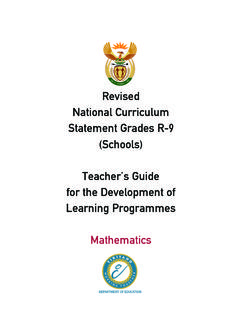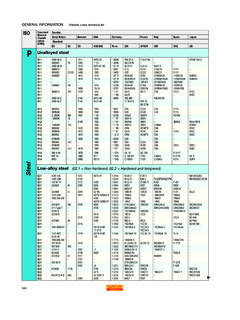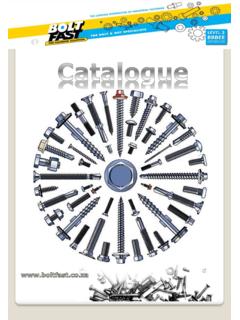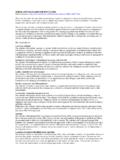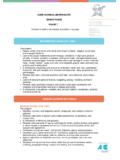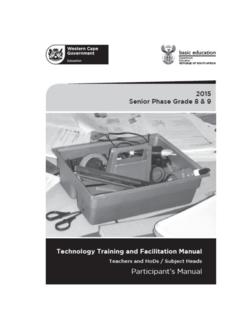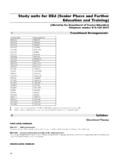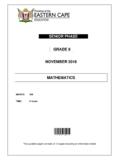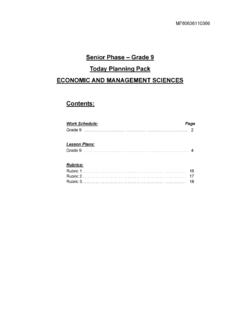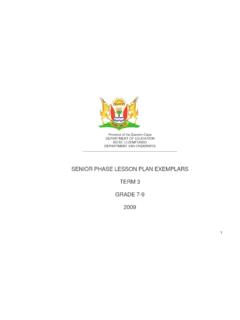Transcription of Geometry - academic.sun.ac.za
1 GeometryModule 2 TransformationsGrades 8 and 9 Teacher documentMalati staff involved in developing these materials:Kate BennieZonia JoosteDumisani MdlaloseRolene LiebenbergPiet HumanSarie SmitWe acknowledge the assistance of Zain Davis, Shaheeda Jaffer, Mthunzi Nxawe andRaymond Smith in shaping our perspectives. COPYRIGHT All the materials developed by MALATI are in the public domain. They may be freely used andadapted, with acknowledgement to MALATI and the Open Society Foundation for South Africa. December 1999 MALATI materials: Geometry , module 21 Malati Geometry : The Transformation ApproachA Common Approach to the Study of Plane Geometry :This problem is commonly used in Geometry in the senior the value of each of the angles p and t. Give reasons for your answersThe mathematical figure in this problem is presented as being static. In order to solvethe problem, learners are required to recognise the pairs of corresponding andalternate angles (this is usually done by recognising the F and the Z in thediagram.)
2 Proofs in two column format are acceptable. The function of proof in sucha case is verification or systematisation (Bell, 1976).Transformation Geometry in the School Curriculum:Traditionally isometric transformations have formed part of the Geometry curriculumin South Africa:x In the study of tessellations (although the transformation aspect is seldom madeexplicit).x As a separate topic in grade 9, sometimes linked to co-ordinate of this work on transformations has, however, been restricted to the perceptuallevel, that is, pupils have been given opportunities to physically manipulate figuresusing cut-outs, paper folding, geoboards, tracings, etc. Learners are seldomchallenged to transfer their perceptual understanding to a representational level, thatis, to perform the operations mentally. It is this ability to perform transformationsmentally that is valuable in is studied informally in grade 9 and more formally in grade 12, but thetransformation dimension (enlargement) is not Broader View of Transformations:Transformations are not, however, restricted to isometric transformations andenlargements.
3 Light (1993) uses the work of Klein to classify the differenttransformations as shown in the table that follows. Examples of the use of eachtransformation and the geometrical context in which each occurs are also given:ABCDE37q42qptMALATI materials: Geometry , module 22 TransformationInvariantsWhatChangesExamp lesGeometricalContextIsometric(translati on,reflection, rotation)shape,distanceposition,orientat iontessellations,symmetry,metricDilation (shrinkingor enlargement)shapesizemaps, plans, toys,models,trigonometry,shadow geometryfrom a point lightsourcesimilarityShears / Stretchesparallelismshapeshadow geometryusing sun as a lightsourceaffineOblique projectioncross ratio /straightnessparallelismperspectivedrawi ngs,photographsperspectiveTransformation sthat do not tearspacecloseness ofpointsStraightness oflinesnetworks,underground mapstopologyMALATI believes that the range of transformations studied at school can be widened the examples mentioned above can be used to study the different transformationson the Van Hiele visual and analysis levels in the intermediate and senior actual differences between the transformations need not be made explicit inthese , certain concepts traditionally taught at school level can be redefinedand studied in terms of transformations:x Congruence.
4 Two figures are congruent if there is a line reflection, translation,rotation or glide reflection that maps one triangle onto the otherx Similarity: Two figures are similar if there is dilation that maps one onto the and Dennis (1968) give the following definitions:x Parallel lines: Two lines are parallel if there is a translation that maps one lineonto anotherx Perpendicular lines: Two lines are perpendicular whenever one is invariant underreflection about the otherx Line symmetry: A figure has line symmetry if it is invariant under a reflection aboutsome points in a plane are described in terms of co-ordinates, transformations canbe expressed algebraically. Matrix representations can also be used to studytransformations in their own materials: Geometry , module 23 MALATI Transformations:MALATI has identified a number of ways in which the use of transformations in theteaching and learning of Geometry can be valuable:x As a means to develop spatial As one method for studying plane As a means to integrate mathematical topics which have traditionally been studiedseparately, for example, the study of plane figures using co-ordinate As a topic of study in its own right the transformations themselves can beregarded as the objects of factors are reflected in the Malati approach to transformations and in thedesign of our materials:Intermediate Phase:Learners explore transformations on the visual van Hiele level.
5 They are required toperform and identify isometric transformations. Enlargements and projections areexplored informally. It is important that learners at this level have rich experiencesphysically manipulating objects, as this forms a foundation for movement to the vanHiele analysis level and the use of visual Phase:In the MALATI activities for this phase, transformations are regarded as a method forstudying plane mentioned above, certain concepts used in the study of plane figures can beredefined using transformations. For example, rather than learners having to use aformal Side-Angle-Side argument to show two triangles congruent, they couldsimply describe the relevant can be used to study the properties of plane figures. Consider theproblem given earlier:Find the value of each of the angles p and t. Give reasons for your answersPupils could argue that, if one translates ECD along line AD so that it lies on BAC,then t = 37q.
6 ECB can be rotated 180q about the midpoint of CB so that it lies on ABC. Hencep = materials: Geometry , module 24 Transformations can also be used to identify line and rotational symmetry inpolygons. These examples are from the MALATI materials:A. Consider the triangle below:1. Reflect the triangle in its sides to make as many different quadrilaterals each case write down the name of the quadrilateral formed, list its propertiesand explain how you got the What if Andile s triangle is an isosceles triangle?B. Write down the value of each of the letters (a) to (c) in this square. Usetransformations to explain your answersThe question might be asked: At what stage do learners begin formal deductivegeometry? . According to the van Hiele theory, learners need a range ofopportunities to explore geometric figures from which they will be able to generalisetheir observations.
7 This activity on the van Hiele analysis level is necessary beforelearners can make deductive arguments on the van Hiele ordering level. In theactivities for the senior phase, learners are given an opportunity to explore theproperties of geometric figures using transformations. After experiences on this level,they should come to recognise that the corresponding angles in parallel lines areequal. When such a generalisation has been made, they will be able to proceed withmore formal, deductive arguments. The foundation for this has, however, been laidusing the above examples transformations are being used as a vehicle to explore otherconcepts, but the properties of the transformations can be explored in their own example, learners can be encouraged to find equivalent transformations and thecomposition of certain materials: Geometry , module 25 Shaughnessy (1995) has placed the study of isometric transformations in the vanHiele Hiele LevelCharacteristic of ThinkingTeaching ObjectiveRecognitionPupil has a global, non-mathematical view recognise each isometryas a movement, and toperform isometries usingappropriate recognise the invarianceof shape and space under consider the propertiesof an explicitly use theproperties that characterisean discover new propertiesof isometries discover compositions use mathematicalnotation and vocabulary can discover anduse properties of and relationsbetween isometries.
8 Canfollow mathematical reasoningand make informal justify and use propertiesof use and understandformal definitions understand and use theintersection of perpendicularbisectors to determine thecentre of understand simple MALATI transformations module includes activities for the study of isometrictransformations at the analysis level. Enlargements (dilations) are explored in depth inthe Malati similarity module (module 2).Consider this activity:MALATI materials: Geometry , module 26 Reflect rectangle ABCD in the line PQ. What is the relationship between ABCDand A'B'C'D'?PADBCQOf course a learner could solve this by using physical manipulation, but if it is donevisually the learner will need to know that the line PQ will be the perpendicularbisector of the line joining a point on ABCD with its image on A'B'C'D'.Learners can also be required to consider the relationships between thetransformations:x Can a combination of two translations always be replaced with onetransformation?
9 And two reflections? Two rotations?x Can a combination of a translation and a reflection always be replaced with onetransformation? And a translation and a rotation? And a reflection and a rotation?x Is the combination of two transformations always commutative?Activities of this nature are classified as enrichment activities in the the summary of activities and Curriculum 2005:Curriculum 2005 recognises different transformations in mathematics and requiresthat learners study the changes in shapes over time. The performance indicators forthe Intermediate phase are as follows:x Identify translationx Identify rotationx Identify reflectionx Identify enlargementx Carry out specified translation, rotation, reflection and enlargementx Realise and show that certain objects change shape and the way these occupyspace when stretched or contracted for a specific length of timex Classify figures in terms of congruencies and similaritiesMALATI materials: Geometry , module 27 senior phase learners are required tox display some transformation Geometry skills on objectsx describe tessellations on shapes (identifying symmetry, similarity and congruency)Learners are also required to work with mapping scales, an aspect of similarity.
10 Therequirement that learners in the senior phase work with a co-ordinate systemincreases the scope for the study of :Bell, A. W. (1976). A study of pupils proof-explanations in mathematical Studies in Mathematics, 7, , R. (1993). Which shape, which space? Mathematics Teacher,145, , & Dennis, (1968). Congruence Geometry for junior high Teacher, 61, (1995). Source materials: Geometry , module 28 Content of MALATI Module 2 (Transformations)This module has an introductory section designed for learners who have not studiedisometric transformations (translation, rotation and reflection) at the primary who have completed these activities should be able to transform geometricfigures as well as recognise given transformations. Initially, some learners mightneed to make copies of the figures and to physically manipulate these, butvisualisation of the movements should be encouraged.
